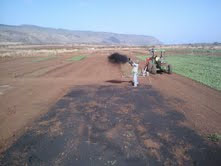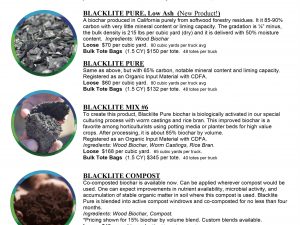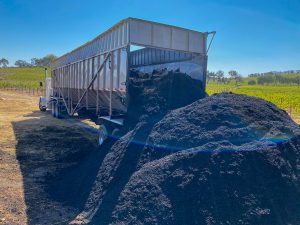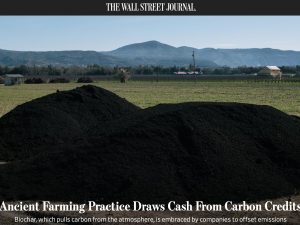
Biochar Trial in Kunia with Pacific Biodiesel Technologies’ Hawaii Military Biofuels Crop (HMBC) Project
Dan Rudoy, the farm manager, holding safflower plants from the biochar (left) and control plots (right).The first field trial with our biochar product on Oahu has yielded some very interesting results. The pictures speak volumes, and the difference in plant growth response appears phenomenal, almost too good. So, I will preface this with one important note: the results shown below are that of our biochar product and are not representative of all biochars in all conditions. We have worked hard to maximize the effectiveness of our biochar products and in doing so have developed a simple process to improve the positive impact they have when used. Apparently it seems to be working.
The Biochar:
Our 1/4″ minus inoculated biochar product.¼â€ minus inoculated with local beneficial microorganisms was used for this experiment. This is our #1 blend. After the biochar has been produced it is processed with a small amount of a locally sourced organic fertilizer and our own fancy compost. The feedstock used to make the biochar in this experiment was a mix of hardwoods from a local sawmill. The biochar was produced using our own “Modified Imu†approach.
The Application Rate:
What it looks like spread in Pacific Biodiesel’s field at about 1/4″ depth.The biochar was applied at ¼ ” thickness. This is equivalent to 33.6 cubic yards per acre. One bulk bag containing 1.5 cubic yards of biochar was used to cover an area just under 2,000 sq. ft. This biochar was then tilled to a depth of approximately 5â€. The end result is that the top 5†of soil now contain about 5% biochar by volume.
The Site:
Kunia, on the North Shore of Oahu, near the Pacific Biodiesel Technologies’ Hawaii Military Biofuels Crop project experimental field.Kunia, on the Mokuleia side of the North Shore. At this 60 acre site, Pacific Biodiesel Technologies has been conducting experiments with oil crops and soil amendments as part of the Hawaii Military Biofuels Crop project (HMBC). The soil type is an Oxisol with a long history of agricultural use. This experiment was conducted under the guidance of Matt Johnson, the project director, and Dan Rudoy, the farm manager. Under these gentlemen’s guidance other collaborative projects are under way at this farm site with a focus on locally available resources.
The Plant: Safflower is an oil crop with a very long history. This plant species has been used by humans for thousands of years. It grows a deep tap-root and does well with relatively low levels of nutrients. The yellow and red flowers are used in making dyes, but the main use of this plant has historically been its seeds, which can yield valuable oil. The Methods: Three plots were analyzed: 1. Control (no fertilizer, no biochar), 2. Biochar, 3. Biochar plus 50lb. N per acre equivalent added as urea. The biochar treatments were added before tilling. To accomplish this a measured amount of biochar was spread evenly over a measured area of soil. The biochar was then tilled in to an approximate depth of 5â€. All plots were planted at the same time. Weeds were not removed. To gather data from the plots, 20 representative plants from each plot were cut at ground level and removed to take measurements.
The Results:
The control plot, with Dan Rudoy as a size reference. The biochar plot, with Dan again as a reference. The biochar plus nitrogen plot.Fresh weight of above ground biomass: Control: 1.4 lbs Biochar: 9 lbs (6.4x control) Biochar + N: 8.2 lbs (5.9x control)
20 representative plants from each plot. From left to right: biochar plus N, control, biochar alone. Seed heads of 20 plants from the control (left) and biochar (right) plots.Fresh weight of seed heads: Control: 0.44 lbs Biochar: 3.69 lbs (8.4x control) Biochar + N: 3.31 lbs (7.5x control) Dry weight yield of seeds: Control: 65.9 Biochar: 171.9 (2.6x control) Biochar + N: 148.4 (2.3x control) Discussion: The yield difference between the control and biochar plots is astounding. This is not the first time this has been observed, but it is one of the first times it has been documented on Oahu under controlled conditions.
It is interesting to note that the safflower plants in the control plot flowered and seeded earlier than all the rest. This is likely due to a stress response – basically the plants did not sense optimal conditions for growth and thus set seed as early as possible to help ensure success, whereas in the other plots the safflower plants were not under such stress which allowed them the luxury to grow larger before setting seed. This can be seen in the pictures and also in the difference between the weights of the whole plants, seed heads and seeds. The seeds of the safflower plants in the control were consistently more mature. The plants had to be harvested at the same time in this study and time was pressing. If a follow up study is done this will be noted.
To explain exactly how the results were achieved is difficult. Not only is the biochar itself responsible for the results seen, but there are also other factors such as plant available nutrients and beneficial microorganisms. Some amount of the response is undoubtedly due to nutrient content in the biochar product. Not only is there a wide range of micronutrients available in the biochar, but at the given application rate, the fertilizer that is added to the biochar during our process amounts to an equivalent of 38.5 lbs of N per acre and 10.7 lbs P per acre. Our process also involves inoculating the biochar with cultures of beneficial microorganisms, these undoubtedly also had an effect on the plant growth response. The compounding factors of biochar + nutrients + biology makes it difficult to piece apart what is going on separately. This is why I mentioned earlier that it is important to remember that these are the results of our biochar product, which was designed to get good results.
It is visible in the pictures, but was even more evident in person that there were much more weeds in the biochar plus nitrogen plot. Dan Rudoy, the farm manager, suspected that the available N created a favorable environment for the weeds, which then took over the plot and reduced the yield potential of the Safflower. There would likely have been a larger yield from that plot otherwise.
The Next Step: The field has already been plowed under and planted with Sunflower seeds. The biochar plots were logged by GPS and can be located in the field later. In a few months we may have the opportunity to get data from a second harvest. This experiment has shown results that warrant further research in the surrounding area.
As part of a continuing effort by Hawaii Biochar Products to learn more about biochar applications in farming, if suitable farms and projects are identified, efforts will be made to facilitate projects. This will often include biochar, plot design, and some amount of data collection provided by Hawaii Biochar Products. If any suitable farms are interested please contact Josiah Hunt by email at: josiah@pacificbiochar.comor simply look to the contact page on this website. If you are interested to learn more about Pacific Biodiesel Technologies, please feel free to visit their website athttp://www.biodiesel.com/






